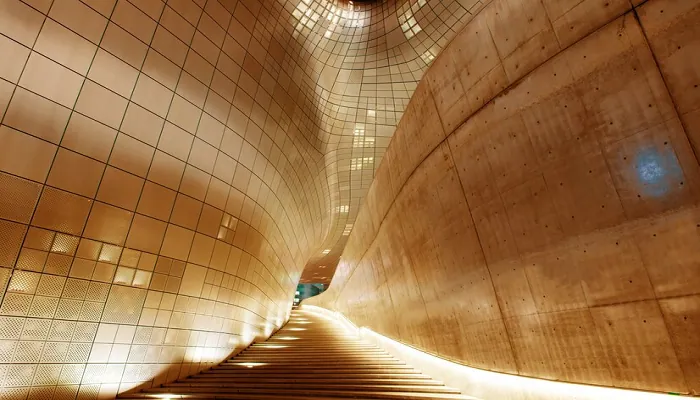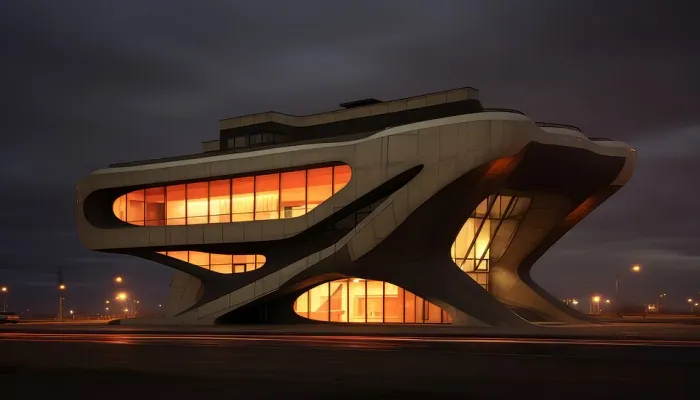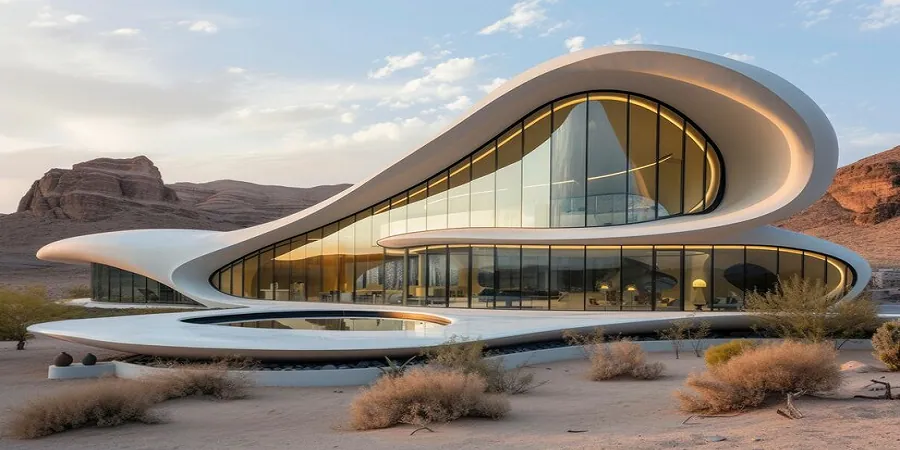Zaha Hadid: A Pioneer in Modern Architecture
Zaha Hadid, an Iraqi-British architect, is celebrated as one of the most innovative and influential architects of the 21st century. Known for her groundbreaking designs and fearless approach to architecture, Hadid has left a lasting mark on the world. Her work is characterized by fluid, organic forms that defy traditional architectural norms, creating spaces that are both visually stunning and functionally advanced.
Significance of Hadid's Bold and Innovative Designs
Hadid's architectural style is bold, pushing the boundaries of what is possible in building design. She was not afraid to challenge conventional ideas, which allowed her to create buildings that stand out for their uniqueness and complexity. Her use of cutting-edge materials and advanced technologies enabled her to bring to life designs that were once considered impossible. The significance of her work lies in its ability to inspire and influence other architects, encouraging them to think creatively and to explore new possibilities in architecture.
Purpose of This Post
The purpose of this post is to explore the key features and impact of Zaha Hadid's architectural style. By examining her most iconic projects and the principles that guided her work, we can gain a deeper understanding of what makes her designs so extraordinary. Whether you are an architecture enthusiast or simply curious about innovative design, this post will provide insights into how Hadid's visionary approach continues to shape the world of architecture today. Her work remains a testament to the power of creativity and innovation in transforming the built environment.
Zaha Hadid: A Visionary Architect

Background on Zaha Hadid’s Career and Achievements
Zaha Hadid was an Iraqi-British architect who became one of the most influential figures in modern architecture. Born in Baghdad in 1950, she studied mathematics before pursuing architecture at the Architectural Association School of Architecture in London. Her career took off in the 1980s, with her unique vision quickly gaining attention. Hadid became the first woman to receive the prestigious Pritzker Architecture Prize in 2004, a testament to her groundbreaking work. Throughout her career, she designed iconic buildings worldwide, from cultural centers to futuristic skyscrapers, earning her numerous awards and global recognition.
Overview of Her Unique Approach to Architecture
Zaha Hadid’s approach to architecture was revolutionary. She was known for her bold, fluid forms that broke away from traditional straight lines and right angles. Her designs often featured sweeping curves, dynamic shapes, and a sense of movement, making her buildings appear as if they were in motion. Hadid embraced cutting-edge technology and innovative materials, allowing her to realize complex designs that were previously thought impossible. Her work was heavily influenced by her interest in abstract art, which she integrated into her architectural concepts, resulting in structures that are both visually striking and functionally innovative.
Importance of Her Contributions to Contemporary Architecture
Zaha Hadid’s contributions to contemporary architecture are immense. She redefined the possibilities of architectural design, inspiring a new generation of architects to think beyond conventional boundaries. Her work demonstrated that architecture could be both artistic and practical, blending form and function in ways that had never been seen before. Hadid’s buildings are not just structures; they are works of art that transform the landscapes they inhabit. Her legacy continues to influence and shape modern architecture, reminding us of the power of creativity and innovation in building a better, more beautiful world.
Key Characteristics of Hadid Architecture

Fluid Forms
One of the most distinctive features of Zaha Hadid’s architecture is her use of fluid, organic forms. Unlike traditional buildings that rely on straight lines and sharp angles, Hadid’s designs flow and curve in a way that mimics natural shapes. This approach creates a sense of movement and dynamism in her structures, making them appear as though they are alive and constantly shifting. Her buildings often resemble natural elements such as waves, rivers, or mountains, blending seamlessly into their environments. These fluid forms are not just aesthetically pleasing but also challenge the conventional boundaries of architectural design.
Innovative Use of Materials
Hadid was known for her innovative use of materials, which allowed her to bring her unique visions to life. She often worked with cutting-edge materials like concrete, glass, and steel in unconventional ways to achieve her signature fluid shapes. Hadid embraced new technologies in construction, such as advanced computer modeling and 3D printing, to push the limits of what was possible in architecture. This use of technology enabled her to create structures that were both visually stunning and structurally sound. Her innovative approach to materials and technology set new standards in the architectural world, inspiring future generations of architects.
Futuristic Designs
Hadid’s designs were always forward-thinking, often appearing futuristic and ahead of their time. She had a visionary approach to architecture, imagining buildings that were not just functional but also embodied the spirit of the future. Her projects often featured bold, unconventional shapes and advanced construction techniques, making them stand out in the urban landscape. This futuristic style reflects Hadid’s belief that architecture should not just respond to the present but also anticipate and shape the future.
Integration with Environment
Another key characteristic of Hadid’s architecture is the thoughtful integration of her buildings with their surroundings. Rather than imposing her designs on the environment, Hadid sought to harmonize her structures with the natural and urban landscapes around them. Her buildings often interact with their environment in unique ways, whether through their fluid forms that mimic natural elements or through their strategic placement to complement the surrounding area. This integration enhances the overall aesthetic and functional value of her projects, making them both beautiful and contextually appropriate.
Iconic Hadid Projects
Heydar Aliyev Center (Baku, Azerbaijan)
.webp)
The Heydar Aliyev Center in Baku, Azerbaijan, is one of Zaha Hadid’s most celebrated works. Its design is a stunning example of her signature fluid forms, with smooth, flowing lines that seem to defy gravity. The building’s exterior appears as a continuous wave, with no sharp angles or visible seams. This fluidity represents a departure from traditional architectural forms, symbolizing Azerbaijan’s modernization and cultural progress. Inside, the center houses exhibition spaces, a conference hall, and a museum, all designed to promote cultural exchange. The Heydar Aliyev Center is not just a building; it’s a work of art that has become a symbol of contemporary architecture in Baku.
MAXXI Museum (Rome, Italy)
.webp)
The MAXXI Museum in Rome, Italy, is another masterpiece by Zaha Hadid, showcasing her ability to create dynamic, innovative spaces. The museum is dedicated to contemporary art and architecture, and its design reflects this modern focus. The building’s layout is a series of interconnected, flowing spaces, with walls that curve and overlap in unexpected ways. This creates a sense of movement and fluidity, guiding visitors through the museum in a unique and engaging manner. The use of natural light and open spaces further enhances the visitor experience, making the MAXXI Museum not just a place to view art, but a piece of art itself.
London Aquatics Centre (London, UK)
.webp)
The London Aquatics Centre, designed for the 2012 Olympic Games, is a prime example of Hadid’s innovative approach to functional design. The building’s wave-like roof is both visually striking and highly functional, covering the large space needed for Olympic swimming events. The fluid shape of the roof reflects the movement of water, creating a strong connection between the building’s form and its purpose. After the Olympics, the center was transformed into a public swimming facility, demonstrating the versatility and lasting impact of Hadid’s design.
Galaxy SOHO (Beijing, China)
 (1).webp)
Galaxy SOHO in Beijing, China, is a remarkable example of Zaha Hadid’s ability to integrate architecture with its urban environment. The complex consists of four interconnected, oval-shaped buildings that flow seamlessly into one another, creating a unified, harmonious structure. The design eliminates the need for sharp angles, instead opting for smooth curves that create a sense of continuity. Galaxy SOHO is a mixed-use development, combining office spaces, retail areas, and entertainment facilities. Its design reflects the fluidity and dynamism of modern urban life, making it a landmark in Beijing’s rapidly changing skyline.
Impact of Hadid's Designs on Modern Architecture

Influence on Contemporary Architectural Trends
Zaha Hadid’s designs have had a profound impact on contemporary architecture. Her innovative use of fluid forms and bold, futuristic designs has influenced many architects around the world. Before Hadid, architecture was often dominated by rigid, geometric forms. However, her work demonstrated that buildings could be dynamic, organic, and visually striking. This shift has inspired a new wave of architects to experiment with unconventional shapes and materials, leading to a broader acceptance of more fluid, free-form structures in modern architecture. Today, many contemporary buildings reflect Hadid’s influence, emphasizing creativity and innovation in design.
The Legacy of Zaha Hadid in Inspiring New Generations of Architects
Zaha Hadid’s legacy extends far beyond the buildings she designed. She has inspired countless young architects to push the boundaries of what is possible in architecture. Hadid broke through numerous barriers in a field that has historically been male-dominated, becoming one of the most celebrated architects of her time. Her success has shown that with vision and determination, it is possible to achieve great things, regardless of gender or background. Many young architects today cite Hadid as a major influence in their careers, and her work continues to be studied in architecture schools around the world.
How Hadid's Work Continues to Challenge Traditional Architectural Norms
Even after her passing, Zaha Hadid’s work continues to challenge and redefine traditional architectural norms. Her designs often defied conventional expectations, pushing the limits of what architecture could be. She questioned the need for symmetry, straight lines, and standard materials, opting instead for fluid, organic forms and innovative construction techniques. This willingness to challenge the status quo has opened up new possibilities in architectural design, encouraging others to think outside the box and explore new ideas. Hadid’s work remains a powerful reminder that architecture is not just about creating functional spaces; it is also about exploring new frontiers and expressing bold, creative visions.
Zaha Hadid's contributions to architecture are monumental, leaving a lasting impact on the field. Her bold, innovative designs revolutionized how we think about buildings, inspiring architects to embrace fluid forms and challenge traditional norms. Hadid's work remains relevant today, continuing to influence contemporary architectural trends and inspire new generations of architects. Her visionary approach serves as a powerful reminder of the importance of creativity and innovation in design. Exploring Hadid's work can offer valuable inspiration for anyone interested in modern architecture, encouraging us to think boldly and push the boundaries of what’s possible.

Comments